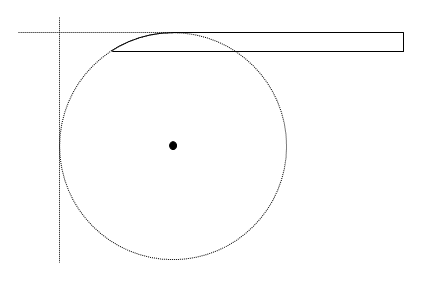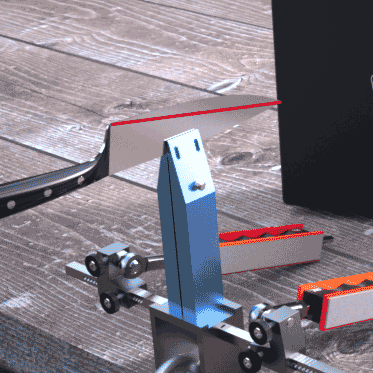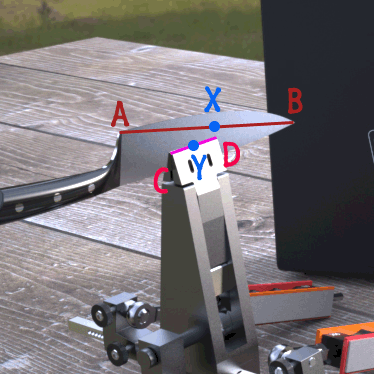Knife mounting
Recent › Forums › Main Forum › Getting Started › Knife mounting
- This topic has 14 replies, 5 voices, and was last updated 11/07/2016 at 8:38 am by
 dulledge.
dulledge.
-
AuthorPosts
-
07/05/2016 at 11:44 am #34528
What is correct way to mount a knife? I read somewhere that you should draw virtual line between back end and front end of knife. Or use actual blue tape. This line should be parallel to vice. Also knife should be centered, so middle of line should be aligned with vertical center of vice.
In other words, Line A-B should be parallel to C-D. Center X should be aligned with center Y. Please correct me if I misunderstand something here. Thank you.
Here are images from WE website. I draw a red line on the images for illustration. Is this right? Or it is not important? If mounting is important, why all pictures on WE website show knives mounted the wrong way?
Attachments:
You must be logged in to access attached files.
1 user thanked author for this post.
07/05/2016 at 3:33 pm #34531The “drawing a line… etc.” method was tried a while back… it worked on a few knives, but I think for the most part was a bust. The instructions that come with the W.E. as well as the instrucitions on the Instructions page, (in particular, Finding the Sweet Spot) will provide a more accurate setup.
1 user thanked author for this post.
07/05/2016 at 3:58 pm #34532The “drawing a line… etc.” method was tried a while back… it worked on a few knives, but I think for the most part was a bust. The instructions that come with the W.E. as well as the instrucitions on the Instructions page, (in particular, Finding the Sweet Spot) will provide a more accurate setup.
On which knives did the Line Method work and on which it didn’t? Did it work on chef’s knives? Could you elaborate? Thank you.
Instructions with Finding the Sweet Spot show how to adjust to existing old bevel. I am not sure if I want to follow existing bevel for every knife. Some knives were sharpened wrong by unknown person and need to be re-sharpened anyway. What will be the Sweet Spot then?
07/05/2016 at 4:33 pm #34533On which knives did the Line Method work and on which it didn’t? Did it work on chef’s knives? Could you elaborate? Thank you.
Instructions with Finding the Sweet Spot show how to adjust to existing old bevel. I am not sure if I want to follow existing bevel for every knife. Some knives were sharpened wrong by unknown person and need to be re-sharpened anyway. What will be the Sweet Spot then?
I can’t tell you which knives it would work on… from what I recall, someone used it, others including myself tried it… it didn’t seem (to me anyway) that it could be used consistently, so I didn’t pursue it.
As for your “Sweet Spot” example… you could still use it, you just adjust for where you do want metal to be removed. So, for example, you receive a knife where the bevel is too wide at the tip, mark it with a Sharpie and set it using #2 in the diagram. If you want to reprofile the whole blade to a lower angle then you could still use #4 in the diagram, but would set the angle so that it removes Sharpie along the entire shoulder.
1 user thanked author for this post.
07/05/2016 at 8:58 pm #34539I use essentially this method for sharpening all of my chef’s knives and find it works very well for me. I don’t measure, draw a line or lay tape across the blade. I just eyeball it. I clamp the blade centered front to back and imagine an arc from the heel to the tip and try to clamp it so a line through the two is roughly parallel to the clamp and centered on the arc.
Marc
(MarcH's Rack-Its)07/06/2016 at 6:48 am #34540I use essentially this method for sharpening all of my chef’s knives and find it works very well for me. I don’t measure, draw a line or lay tape across the blade. I just eyeball it. I clamp the blade centered front to back and imagine an arc from the heel to the tip and try to clamp it so a line through the two is roughly parallel to the clamp and centered on the arc.
Yes, thank you. Geometrically the Line method seems to create the most even bevel on all length from heel to tip. And with most consistent angle.
1 user thanked author for this post.
07/06/2016 at 8:58 am #34541I now am using the Gen 3 Pro mounted flat on the granite base without the shelf. I try to set and clamp the knife spine down against the depth key in the lower position towards the heel of the knife and raise the tip to create this even arc moving the knife forward or aft as needed to even the length out. I use the metal measure stick towards the point then flip it over and use it towards the heel to verify I’m essentially even. The first time I sharpen a particular knife I use the marker to verify I’ve found the sweet spot with this placement. I visually verify my progress and results with an USB microscope. After I finish I log my angles. I find I have good repeatability if I use the same method to remount the knives for subsequent resharpening. The Gen 3 pro makes clamping much quicker, easier and tighter. It’s real quick and easy for me to switch from my diamond paddles to Shapton Wet Stones with four clicks or 2 degrees increase in angle to compromise for the extra thickness of the wet stones to maintains the same set sharpening angle. Of course I verify or double check with an angle cube every paddle grit change. I’m getting the best results I ever have in the two years using the WE since I started with the Gen 2 Pro. I also adapted my Gen 2 with the Gen 3 clamp and use this for uneven bevel Chef’s knives,(e.g. 70/30) where I set the arms individually.
I only sharpen kitchen knives that I use for myself. I’m only concerned about sharpness and durability. I don’t try to achieve a mirror polish but usually end up very close to one if I take my time and follow technique carefully in particular keeping the paddles flat against the bevel, use vey light pressure and maintain the same hand placement throughout the process and don’t roll the paddles. I usually don’t strop the finished edge to leave it a little toothy. I’m not really bothered if the bevel width is a little off from side to side as long as my results are scary sharp.
Marc
(MarcH's Rack-Its)1 user thanked author for this post.
07/06/2016 at 9:29 am #34542I try to set and clamp the knife spine down against the depth key in the lower position towards the heel of the knife and raise the tip to create this even arc moving the knife forward or aft as needed to even the length out. I use the metal measure stick towards the point then flip it over and use it towards the heel to verify I’m essentially even.
This is a different (and better) setup process then what the first post is talking about… it’s described in the Advanced Alignment Guide thread (at around p. 10 or 11). Even it isn’t 100%… but does seem to work well on knives without a lot of curve (so the Chef’s knife would be a good example).
07/06/2016 at 11:31 am #34543it’s described in the Advanced Alignment Guide thread (at around p. 10 or 11).
Thank you for the link. A lot of information there. This post turns my world upside down.

1 user thanked author for this post.
07/06/2016 at 3:01 pm #34545I don’t have patience to dance around clamp with marker for half hour to find “Sweet Spot”. I’d rather use Line method and re-profile bevel if it needs to be. Then use the Line method for the rest of my life on this knife without thinking and worrying. Quick and repeatable.
Maybe “Advanced Alignment” is needed on some expensive client’s jobs to keep existing bevel as is. But for my own knives the “Advanced Alignment” is too much trouble. Life is too short.
07/06/2016 at 5:02 pm #34546A few minutes, maybe. Nowhere near 30.
1 user thanked author for this post.
07/07/2016 at 6:44 pm #34547I agree that finding the “Sweet Spot” is preferable method for existing bevel that you want to preserve.
What method would you prefer if you want to re-profile knife from scratch? How would you mount it?
07/07/2016 at 8:38 pm #34549I mount it the same way as I posted above. I always try to find the sweet spot no matter for sharpening existing bevels or re-profiling. The sweet spot allows me to reach the full length of the bevel from heal to tip so I can sharpening the knife while removing the least amount of metal still maintaining the knife’s shape the maker intended it to be, and not having to move and re-clamp the knife to work on it in sections. For me I consider re-profiling changing the original bevel angle, not reshaping the blade.
Marc
(MarcH's Rack-Its)1 user thanked author for this post.
07/08/2016 at 1:25 am #34552For all but the most expensive blades, I try to use the most repeatable mounting positions. For folding knives, this means holding the spine flat against the two pins in their upper of lower positions and place the bolster tight up against the vise. Bingo, all my folders (I’ve got a bunch) are repeatable. For other blades, I record the upper or lower key position, the distance from the tip to the vise and if necessary, the angle of the edge at the heel, relative to horizontal.
2 users thanked author for this post.
11/07/2016 at 8:38 am #35734After a long thought I see 3 methods of mounting knife.
1. Constant angle method. Mark76 is correct in this post. Bevel angle is constant on horizontal line and on circle. Vertical center of vice and vertical center of the circle should be aligned.

2. Line method. Only when angle constancy is not critical, then Line method can be used for quick and easy repeatability, like MarcH explained here. Line method doesn’t provide constant angle.
3. Sweet spot method allows to find and adjust to original existing bevel angle. Sweet spot method is needed when you want to keep existing angle, but it is not needed if you want to reshape and make a different angle.
Thank you very much to all for your help.

Attachments:
You must be logged in to access attached files.
1 user thanked author for this post.
-
AuthorPosts
- You must be logged in to reply to this topic.

